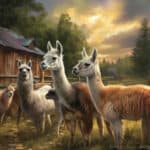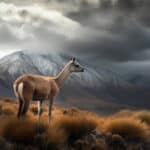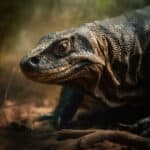Komodo dragons, the largest lizards on Earth, are fascinating creatures that inhabit the Indonesian islands of Komodo, Rinca, Flores, Gili Motang, and Padar. These reptiles have captured the imagination of people worldwide due to their immense size, powerful jaws, and predatory nature. While they primarily feed on a diet of carrion and live prey such as deer, pigs, and water buffalo, there have been rare instances where Komodo dragons have attacked humans. In this article, we will explore the question: do Komodo dragons eat people? We will delve into the behavior and feeding habits of these formidable reptiles, examine documented cases of human encounters, and separate fact from fiction. So, let’s embark on this journey to uncover the truth about the relationship between Komodo dragons and humans.
Key Takeaways
- Komodo dragons are capable of attacking and killing humans, although such incidents are extremely rare.
- Komodo dragons primarily feed on large prey such as deer and pigs, and humans are not a preferred food source.
- Human encounters with Komodo dragons should be avoided, and caution should be exercised when visiting areas where they are found.
Understanding Komodo Dragons
Komodo dragons, also known as Varanus komodoensis, are fascinating creatures that inhabit the islands of Indonesia, particularly the Komodo National Park. These large lizard species are renowned for their impressive size, unique hunting techniques, and carnivorous diet. In this section, we will delve into the natural habitat of Komodo dragons, their diet, and their hunting techniques.
A. The Natural Habitat of Komodo Dragons
Komodo dragons are native to the Indonesian islands of Komodo, Rinca, Flores, Gili Motang, and Padar. These islands provide the perfect environment for these reptiles to thrive. The Komodo National Park, a UNESCO World Heritage Site, serves as a protected area for these endangered creatures.
The natural habitat of Komodo dragons consists of a combination of savannahs, grasslands, and tropical forests. These regions offer an abundance of prey, such as deer, wild boar, water buffalo, and smaller reptiles. The warm climate and diverse vegetation provide the necessary resources for the survival of these apex predators.
B. The Diet of Komodo Dragons
Komodo dragons are carnivorous reptiles with a voracious appetite. They are opportunistic hunters and will consume almost anything they can overpower. Their diet primarily consists of large mammals, including deer and water buffalo. However, they are not averse to scavenging on carrion when the opportunity arises.
These formidable predators possess a unique hunting strategy. They rely on their keen sense of smell to detect the scent of decaying flesh from miles away. Once they locate a potential meal, they patiently wait for the perfect moment to strike. With their powerful legs and sharp claws, they pounce on their prey, delivering a quick and lethal bite.
C. The Hunting Techniques of Komodo Dragons
Komodo dragons are known for their stealth and patience when it comes to hunting. They possess a venomous bite that aids in subduing their prey. While their bite alone is not enough to kill instantly, the venom contains harmful bacteria that can cause severe infections.
Once the prey is bitten, the Komodo dragon patiently tracks it until it succumbs to the venom or the resulting infection. This hunting technique allows the Komodo dragon to conserve energy while waiting for its meal to weaken. It then uses its powerful jaws and serrated teeth to tear apart the carcass, consuming both flesh and bones.
Despite their size and strength, Komodo dragons are not known to actively hunt humans. There have been rare instances of human-Komodo dragon interactions, but these are typically a result of accidental encounters rather than intentional predation. The Komodo National Park has implemented measures to ensure the safety of visitors, minimizing the risk of such encounters.
In conclusion, Komodo dragons are fascinating creatures that have adapted to their unique environment. Their natural habitat provides the necessary resources for their survival, and their carnivorous diet consists of large mammals and carrion. Their hunting techniques, including their venomous bite, make them formidable predators. While they are not known to actively prey on humans, it is important to exercise caution and respect their natural habitat when visiting the Komodo National Park.
The Controversial Question: Do Komodo Dragons Eat Humans?

Komodo dragons, the largest lizards on Earth, are fascinating creatures that inhabit the Indonesian islands of Komodo, Rinca, Flores, Gili Motang, and Padar. These apex predators have captured the imagination of people around the world, but there is a lingering question that often arises: do Komodo dragons eat humans? Let’s explore this controversial topic from historical incidents and scientific perspectives to understand the truth behind these claims.
A. Historical Incidents of Komodo Dragons Attacking Humans
Over the years, there have been several reported incidents of Komodo dragons attacking humans. These encounters have often resulted in serious injuries or even fatalities. One notable incident occurred in 2001 when a group of divers was attacked by a Komodo dragon on Komodo Island. The attack left one of the divers severely injured, highlighting the potential danger these creatures can pose.
While such incidents are rare, they have contributed to the perception that Komodo dragons are dangerous predators capable of preying on humans. However, it is important to note that these attacks are not a regular occurrence and are often a result of human encroachment into the dragons’ natural habitat.
B. Scientific Perspective: Can a Komodo Dragon Eat a Human?
To answer the question of whether Komodo dragons can eat humans, we need to examine their biology and feeding habits. Komodo dragons are carnivorous reptiles with a varied diet that includes deer, pigs, water buffalo, and other large animals. They are opportunistic hunters and have been known to take down prey much larger than themselves.
Komodo dragons have a powerful bite and sharp teeth, which they use to immobilize and kill their prey. While they are capable of inflicting serious injuries, their primary hunting strategy involves biting their prey and then waiting for the venom in their saliva to take effect. This venom contains a mix of bacteria that can cause septicemia, leading to the eventual demise of the prey.
In terms of their ability to eat humans, it is highly unlikely. Komodo dragons are not built to consume large prey in one sitting. Their stomachs are relatively small, and they lack the ability to tear off large chunks of flesh. Instead, they rely on their strong jaws and serrated teeth to rip apart their prey into smaller pieces that can be swallowed whole.
C. Why Would a Komodo Dragon Attack a Human?
While Komodo dragons do not typically view humans as prey, there are instances where they may attack if they feel threatened or provoked. These creatures are territorial and can become aggressive if they perceive a threat to their habitat or themselves. Approaching too closely or invading their personal space can trigger defensive behavior, leading to an attack.
Additionally, Komodo dragons have a keen sense of smell and can be attracted to the scent of blood or decaying flesh. In rare cases, if a human is injured or bleeding, it may attract the attention of a Komodo dragon, potentially leading to an attack.
It is important to remember that Komodo dragons are a protected and endangered species. They play a vital role in the ecosystem of Komodo National Park and should be respected from a safe distance. Any interactions with these creatures should be done under the guidance of trained professionals to ensure the safety of both humans and the dragons themselves.
In conclusion, while there have been historical incidents of Komodo dragons attacking humans, these occurrences are rare and often a result of human encroachment or provocation. From a scientific perspective, it is highly unlikely for a Komodo dragon to eat a human due to their feeding habits and physical limitations. However, it is crucial to exercise caution and respect when encountering these magnificent creatures in their natural habitat.
Do Komodo Dragons Eat Dogs and Other Domestic Animals?
A. Incidents of Komodo Dragons Attacking Dogs
Komodo dragons are formidable predators known for their size and strength. While they primarily feed on a diet of large prey such as deer, water buffalo, and wild boar, there have been rare instances of Komodo dragons attacking dogs and other domestic animals.
These incidents typically occur when domestic animals venture into the natural habitat of the Komodo dragon, such as the Komodo National Park in Indonesia. The park is home to a significant population of Komodo dragons, making it more likely for encounters to happen.
When a Komodo dragon encounters a dog or another domestic animal, it may perceive it as potential prey. Komodo dragons have a keen sense of smell and can detect the scent of animals from a considerable distance. This, combined with their opportunistic nature, may lead them to view domestic animals as an easy meal.
B. Why Komodo Dragons Might Be Attracted to Domestic Animals
There are several reasons why Komodo dragons might be attracted to domestic animals:
-
Availability: Domestic animals, such as dogs and goats, are often more accessible to Komodo dragons than their natural prey. They are often found in human settlements or areas close to human activity, making them easier targets for the dragons.
-
Opportunistic Behavior: Komodo dragons are opportunistic hunters and will take advantage of any available food source. If a domestic animal is within their reach, they may seize the opportunity to feed on it.
-
Unfamiliarity: Domestic animals may not be familiar with the presence of Komodo dragons and may not recognize them as a threat. This lack of awareness can make them vulnerable to an attack.
-
Scavenging Behavior: Komodo dragons are known to scavenge on carrion, including the remains of dead animals. If a domestic animal dies in the vicinity of a Komodo dragon, it may be attracted to the scent and feed on the carcass.
It is important to note that while incidents of Komodo dragons attacking domestic animals have been reported, they are relatively rare. Komodo dragons primarily rely on their natural prey for sustenance and are not actively seeking out domestic animals as a food source.
In conclusion, while Komodo dragons have been known to attack dogs and other domestic animals, these incidents are infrequent and generally occur when the animals encroach upon the dragon’s territory. It is crucial for pet owners and individuals living in areas with Komodo dragon populations to take precautions to ensure the safety of their pets and livestock.
The Dark Side of Komodo Dragons: Cannibalistic Behavior

A. Why Do Komodo Dragons Eat Their Babies?
Komodo dragons, the largest lizards on Earth, are known for their formidable size, strength, and predatory nature. While they primarily feed on a diet of large mammals, birds, and reptiles, there have been instances where these creatures have been observed engaging in cannibalistic behavior, including the consumption of their own offspring. This raises the question: why do Komodo dragons eat their babies?
One possible explanation for this behavior is the scarcity of resources in their natural habitat. Komodo dragons inhabit the islands of Indonesia, where food can be scarce at times. When resources are limited, adult Komodo dragons may resort to eating their own young as a means of survival. By eliminating competition for food, the adults increase their own chances of survival and reproduction.
Another reason for cannibalism among Komodo dragons is the instinct to maintain a strong genetic lineage. In the wild, the survival of the fittest is crucial for the species’ long-term survival. By consuming weaker or sickly offspring, the adult Komodo dragons ensure that only the strongest genes are passed on to the next generation. This behavior helps maintain the overall health and vitality of the population.
B. Do Komodo Dragons Eat Human Corpses?
Komodo dragons are apex predators and have been known to attack and consume a wide range of prey, including deer, pigs, and even water buffalo. However, despite their fearsome reputation, there is limited evidence to suggest that Komodo dragons actively seek out human prey or consume human corpses.
While there have been rare cases of Komodo dragons attacking humans, these incidents are typically a result of the dragons feeling threatened or defending their territory. Komodo dragons are generally shy and prefer to avoid human interaction. They are more likely to flee from humans than to actively pursue them as prey.
In terms of consuming human corpses, there is no documented evidence to support this claim. Komodo dragons primarily rely on live prey for sustenance and are unlikely to scavenge on already deceased animals, including humans. Their hunting strategy involves ambushing and overpowering their prey, which is typically done with a quick and powerful bite.
In conclusion, while Komodo dragons are formidable predators, there is no substantial evidence to suggest that they actively seek out humans as prey or consume human corpses. Their diet primarily consists of live prey, and instances of human attacks are rare and usually occur in self-defense. It is important to respect the natural habitat of these fascinating creatures and maintain a safe distance to avoid any potential conflicts.
The Relationship Between Komodo Dragons and Indonesians

A. The Cultural Significance of Komodo Dragons in Indonesia
Komodo dragons hold a special place in the hearts and culture of Indonesians. These majestic creatures are native to the Indonesian islands of Komodo, Rinca, Flores, Gili Motang, and Padar. The Komodo dragon, known locally as “ora,” is not only the largest living lizard species but also a symbol of pride and strength for the Indonesian people.
In Indonesian folklore and mythology, the Komodo dragon is often revered as a powerful and mythical creature. It is believed to possess supernatural abilities and is associated with various legends and stories passed down through generations. The dragon’s presence in Indonesian culture is evident in traditional dances, art, and even the local currency, where it is featured on the Indonesian 5,000 rupiah banknote.
B. Do Indonesians Fear Komodo Dragons?
While Komodo dragons are respected and admired, there is a healthy level of caution and respect for these formidable creatures. Indonesians are well aware of the potential danger posed by Komodo dragons and understand the importance of maintaining a safe distance. However, it is important to note that Indonesians do not live in constant fear of Komodo dragons.
The local communities have learned to coexist with these reptiles, understanding their behavior and habitat. They have developed a deep understanding of the dragon’s natural instincts and have adapted their lifestyles accordingly. This knowledge allows Indonesians to navigate the Komodo dragon’s territory without undue fear.
C. How Indonesians Protect Themselves and Their Livestock from Komodo Dragons
Indonesians have implemented various measures to protect themselves and their livestock from potential encounters with Komodo dragons. These measures are designed to minimize the risk of conflicts and ensure the safety of both humans and animals.
-
Education and Awareness: Local communities receive education and training on Komodo dragon behavior, including how to identify signs of aggression and how to respond appropriately. This knowledge empowers individuals to make informed decisions when encountering these creatures.
-
Secure Enclosures: Livestock owners often construct secure enclosures to protect their animals from Komodo dragon attacks. These enclosures are built with sturdy fencing and reinforced structures to prevent the entry of these large reptiles.
-
Nighttime Vigilance: Indonesians are cautious during the night, as Komodo dragons are more active during this time. They take extra precautions to ensure the safety of their surroundings and livestock, such as keeping animals indoors or in secure enclosures.
-
Avoiding Attractants: Indonesians are mindful of not leaving food or waste in open areas, as this can attract Komodo dragons. By properly disposing of waste and keeping their surroundings clean, they reduce the likelihood of attracting these carnivorous reptiles.
-
Conservation Efforts: Indonesians actively participate in conservation efforts to protect the Komodo dragon population and their natural habitat. Organizations like the Komodo Survival Program work closely with local communities to promote sustainable practices and ensure the long-term survival of these endangered species.
In conclusion, the relationship between Komodo dragons and Indonesians is one of respect, cultural significance, and coexistence. While Indonesians acknowledge the potential danger these creatures pose, they have developed strategies to protect themselves and their livestock, allowing both humans and Komodo dragons to thrive in their shared environment.
The Role of Conservation Efforts
A. Protecting Humans and Livestock from Komodo Dragons
Conservation efforts play a crucial role in ensuring the safety of both humans and livestock living in close proximity to Komodo dragon habitats. While it is rare for Komodo dragons to intentionally target humans as prey, there have been instances where these powerful creatures have attacked people. Therefore, it is important to implement measures that protect local communities and their livestock from potential encounters with these formidable predators.
One approach to safeguarding humans and livestock is through education and awareness programs. By educating local communities about the behavior and habits of Komodo dragons, people can learn how to coexist with these creatures while minimizing the risk of conflicts. These programs can provide valuable information on how to avoid attracting Komodo dragons, such as not leaving food or waste in open areas, securing livestock enclosures, and being cautious when venturing into areas known to be inhabited by these reptiles.
In addition to education, physical barriers can also be employed to prevent Komodo dragons from accessing human settlements and livestock areas. Fences and enclosures can be constructed to create a buffer zone between the dragons and the local communities. These barriers can help reduce the chances of accidental encounters and protect livestock from becoming potential prey.
B. Protecting Komodo Dragons from Human Threats
Conservation efforts are not only focused on protecting humans and livestock from Komodo dragons but also on safeguarding these magnificent creatures from human threats. Komodo dragons are classified as an endangered species, and their population is at risk due to various factors, including habitat loss, poaching, and climate change.
To protect Komodo dragons, it is crucial to preserve their natural habitats. Komodo National Park, located in Indonesia, is a designated protected area that serves as a sanctuary for these reptiles. The park‘s management implements strict regulations to ensure the preservation of the dragons’ natural environment, limiting human activities that may disrupt their habitats.
Furthermore, anti-poaching measures are essential in combating illegal hunting and trading of Komodo dragons. These reptiles are highly sought after in the illegal wildlife trade due to their rarity and unique characteristics. By enforcing laws and increasing surveillance, authorities can deter poachers and reduce the demand for these endangered creatures.
Climate change poses another significant threat to Komodo dragons. Rising temperatures and sea levels can impact the dragons’ nesting sites and prey availability. Conservation efforts must include measures to mitigate the effects of climate change and protect the ecosystems that support the survival of these reptiles.
In conclusion, conservation efforts play a vital role in both protecting humans and livestock from potential encounters with Komodo dragons and safeguarding these magnificent creatures from human threats. Through education, physical barriers, habitat preservation, anti-poaching measures, and climate change mitigation, we can ensure the long-term survival of Komodo dragons while promoting harmonious coexistence between humans and these fascinating reptiles. Conclusion
In conclusion, while there have been rare instances of komodo dragons attacking humans, it is not their natural behavior to actively seek out and prey on people. These large reptiles primarily feed on a diet of carrion and smaller animals, using their powerful jaws and venomous bite to immobilize their prey. Although their size and strength make them formidable predators, they generally avoid human interaction and are not considered a significant threat to human safety. It is important to remember that respecting their natural habitat and observing them from a safe distance is crucial to ensuring both human and komodo dragon well-being.
Frequently Asked Questions
What do Indonesians eat?
Indonesians have a diverse diet due to the country’s rich cultural and geographical diversity. The staple food is rice, accompanied by a variety of dishes made from vegetables, meat, fish, and poultry. Some popular dishes include Nasi Goreng (fried rice), Satay (skewered grilled meat), and Rendang (a spicy meat dish).
How do Komodo dragons eat?
Komodo dragons are carnivorous reptiles and have a unique way of eating. They use their sharp, serrated teeth to tear apart their prey. They also have a venomous bite that can paralyze their prey. Komodo dragons can eat up to 80% of their body weight in a single meal.
Do Indonesians eat Komodo dragons?
No, Indonesians do not eat Komodo dragons. The Komodo dragon is a protected species in Indonesia and is found in the Komodo National Park. Killing or consuming these creatures is illegal and punishable by law.
Do Komodo dragons eat dogs?
Yes, Komodo dragons can eat dogs. They are opportunistic feeders and can eat almost any kind of meat. However, their natural diet primarily consists of large mammals like deer, pigs, and even smaller dragons.
Can a Komodo dragon eat a human?
While rare, there have been reported cases of Komodo dragons attacking and eating humans. However, such incidents are not common as Komodo dragons usually do not see humans as prey and attacks often occur when the dragons feel threatened.
Do Komodo dragons eat human corpses?
Komodo dragons are scavengers and will eat carrion, including human corpses if available. However, such instances are rare as human corpses are not a typical part of their diet.
Can Komodo dragons eat humans?
Yes, they can, but it is extremely rare. Komodo dragons are capable of killing and eating humans due to their size, strength, and venomous bite. However, they usually do not see humans as prey.
Why do Komodo dragons eat their babies?
Komodo dragons do not typically eat their own babies. However, adult dragons are known to be cannibalistic and may eat younger, smaller dragons if food is scarce. To avoid this, baby Komodo dragons often live in trees until they are large enough to defend themselves.
Where do Komodo dragons eat?
Komodo dragons eat in their natural habitat, which is primarily the islands within Komodo National Park in Indonesia. They are ambush predators and usually wait for their prey to come close before attacking.
What is the diet of a Komodo dragon?
Komodo dragons are carnivores and their diet primarily consists of carrion. They also hunt and eat a variety of animals, including deer, pigs, smaller dragons, and occasionally humans. They have been known to eat up to 80% of their body weight in a single meal.




